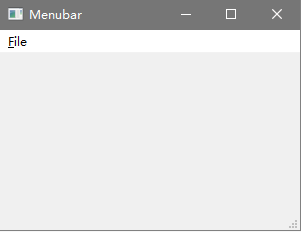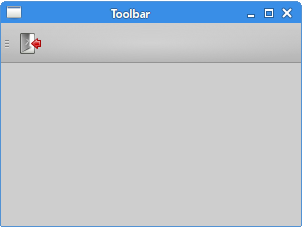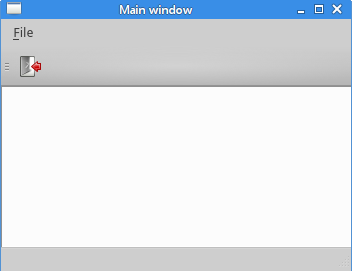这部分PyQt5教程中,我们将创建菜单和工具栏
主窗口
QMainWindow 类提供了一个主要的应用程序窗口。你用它可以让应用程序添加状态栏,工具栏和菜单栏。
状态栏
状态栏用于显示状态信息
import sys
from PyQt5.QtWidgets import QMainWindow, QApplication
class Example(QMainWindow):
def __init__(self):
super().__init__()
self.initUI()
def initUI(self):
self.statusBar().showMessage('Ready')
self.setGeometry(300, 300, 250, 150)
self.setWindowTitle('Statusbar')
self.show()
if __name__ == '__main__':
app = QApplication(sys.argv)
ex = Example()
sys.exit(app.exec_())你用QMainWindow创建状态栏的小窗口。
self.statusBar().showMessage('Ready').QMainWindow类第一次调用statusBar() 方法创建一个状态栏。后续调用返回状态栏对象。首位Message() 状态栏上显示一条消息。
菜单栏
菜单栏是常见的窗口应用程序的一部分。(Mac Os 将菜单条不同。得到类似的结果,我们可以添加以下行:menubar.setNativeMenuBar(假)。)
import sys
from PyQt5.QtWidgets import QMainWindow, QAction, qApp, QApplication
from PyQt5.QtGui import QIcon
class Example(QMainWindow):
def __init__(self):
super().__init__()
self.initUI()
def initUI(self):
exitAction = QAction(QIcon('exit.png'), '&Exit', self)
exitAction.setShortcut('Ctrl+Q')
exitAction.setStatusTip('Exit application')
exitAction.triggered.connect(qApp.quit)
self.statusBar()
#创建一个菜单栏
menubar = self.menuBar()
#添加菜单
fileMenu = menubar.addMenu('&File')
#添加事件
fileMenu.addAction(exitAction)
self.setGeometry(300, 300, 300, 200)
self.setWindowTitle('Menubar')
self.show()
if __name__ == '__main__':
app = QApplication(sys.argv)
ex = Example()
sys.exit(app.exec_()) 在上面的例子中,我们创建一个菜单栏和一个菜单。这个菜单将终止应用程序。Ctrl+Q的行动是可以访问的快捷方式。
exitAction = QAction(QIcon('exit.png'), '&Exit', self)
exitAction.setShortcut('Ctrl+Q')
exitAction.setStatusTip('Exit application')QAction 可以操作菜单栏、工具栏或自定义键盘快捷键。上面三行,我们创建一个事件和一个特定的图标和一个“退出”的标签。然后,在定义该操作的快捷键。第三行创建一个鼠标悬停在该菜单项上时的提示
exitAction.triggered.connect(qApp.quit)当点击菜单的时候,调用qApp.quit , 终止应用程序。如图

工具栏
工具栏提供了一个快速房访问的入口。
import sys
from PyQt5.QtWidgets import QMainWindow, QAction, qApp, QApplication
from PyQt5.QtGui import QIcon
class Example(QMainWindow):
def __init__(self):
super().__init__()
self.initUI()
def initUI(self):
exitAction = QAction(QIcon('exit24.png'), 'Exit', self)
exitAction.setShortcut('Ctrl+Q')
exitAction.triggered.connect(qApp.quit)
self.toolbar = self.addToolBar('Exit')
self.toolbar.addAction(exitAction)
self.setGeometry(300, 300, 300, 200)
self.setWindowTitle('Toolbar')
self.show()
if __name__ == '__main__':
app = QApplication(sys.argv)
ex = Example()
sys.exit(app.exec_())在上面的例子中,我们创建一个简单的工具栏。工具栏有一个按钮,点击管不窗口。
exitAction = QAction(QIcon('exit24.png'), 'Exit', self)
exitAction.setShortcut('Ctrl+Q')
exitAction.triggered.connect(qApp.quit)类似于上面的菜单栏的例子,我们创建一个QAction事件。改事件有一个标签、图标和快捷键。退出窗口的方法。

我们把菜单条、工具栏和状态栏放在一起的窗口
import sys
from PyQt5.QtWidgets import QMainWindow, QTextEdit, QAction, QApplication
from PyQt5.QtGui import QIcon
class Example(QMainWindow):
def __init__(self):
super().__init__()
self.initUI()
def initUI(self):
textEdit = QTextEdit()
self.setCentralWidget(textEdit)
exitAction = QAction(QIcon('exit24.png'), 'Exit', self)
exitAction.setShortcut('Ctrl+Q')
exitAction.setStatusTip('Exit application')
exitAction.triggered.connect(self.close)
self.statusBar()
menubar = self.menuBar()
fileMenu = menubar.addMenu('&File')
fileMenu.addAction(exitAction)
toolbar = self.addToolBar('Exit')
toolbar.addAction(exitAction)
self.setGeometry(300, 300, 350, 250)
self.setWindowTitle('Main window')
self.show()
if __name__ == '__main__':
app = QApplication(sys.argv)
ex = Example()
sys.exit(app.exec_())创建了一个窗口
textEdit = QTextEdit()
self.setCentralWidget(textEdit)我们创建了一个 QTextEdit 并把它设置为窗口布局

发表回复